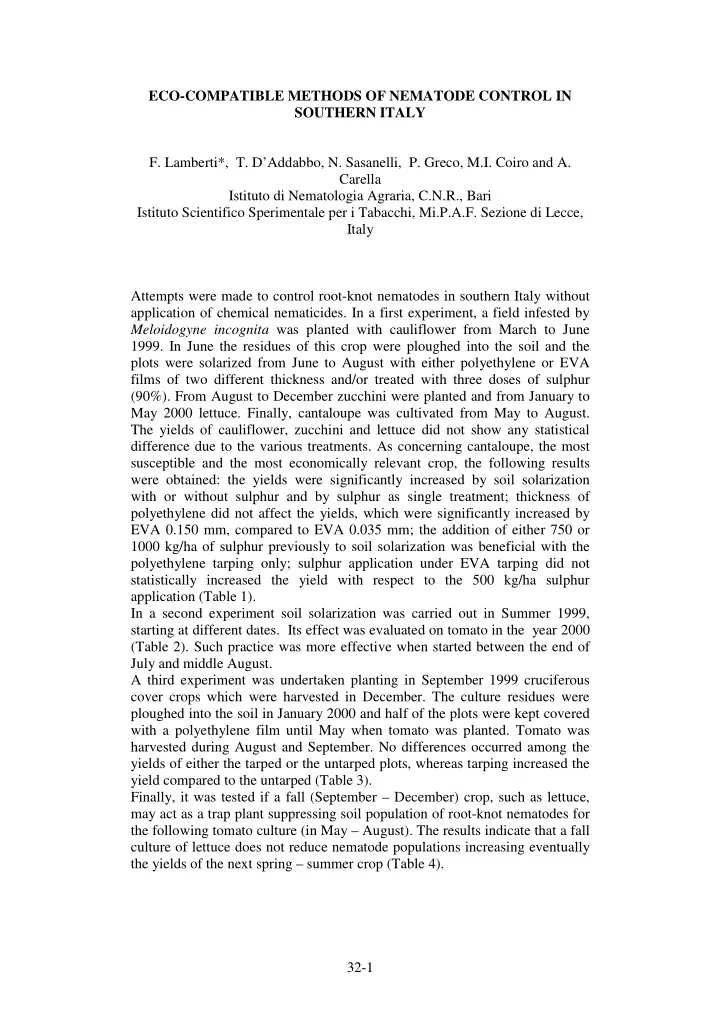

ECO-COMPATIBLE METHODS OF NEMATODE CONTROL IN SOUTHERN ITALY F. Lamberti*, T. D’Addabbo, N. Sasanelli, P. Greco, M.I. Coiro and A. Carella Istituto di Nematologia Agraria, C.N.R., Bari Istituto Scientifico Sperimentale per i Tabacchi, Mi.P.A.F. Sezione di Lecce, Italy Attempts were made to control root-knot nematodes in southern Italy without application of chemical nematicides. In a first experiment, a field infested by Meloidogyne incognita was planted with cauliflower from March to June 1999. In June the residues of this crop were ploughed into the soil and the plots were solarized from June to August with either polyethylene or EVA films of two different thickness and/or treated with three doses of sulphur (90%). From August to December zucchini were planted and from January to May 2000 lettuce. Finally, cantaloupe was cultivated from May to August. The yields of cauliflower, zucchini and lettuce did not show any statistical difference due to the various treatments. As concerning cantaloupe, the most susceptible and the most economically relevant crop, the following results were obtained: the yields were significantly increased by soil solarization with or without sulphur and by sulphur as single treatment; thickness of polyethylene did not affect the yields, which were significantly increased by EVA 0.150 mm, compared to EVA 0.035 mm; the addition of either 750 or 1000 kg/ha of sulphur previously to soil solarization was beneficial with the polyethylene tarping only; sulphur application under EVA tarping did not statistically increased the yield with respect to the 500 kg/ha sulphur application (Table 1). In a second experiment soil solarization was carried out in Summer 1999, starting at different dates. Its effect was evaluated on tomato in the year 2000 (Table 2). Such practice was more effective when started between the end of July and middle August. A third experiment was undertaken planting in September 1999 cruciferous cover crops which were harvested in December. The culture residues were ploughed into the soil in January 2000 and half of the plots were kept covered with a polyethylene film until May when tomato was planted. Tomato was harvested during August and September. No differences occurred among the yields of either the tarped or the untarped plots, whereas tarping increased the yield compared to the untarped (Table 3). Finally, it was tested if a fall (September – December) crop, such as lettuce, may act as a trap plant suppressing soil population of root-knot nematodes for the following tomato culture (in May – August). The results indicate that a fall culture of lettuce does not reduce nematode populations increasing eventually the yields of the next spring – summer crop (Table 4). 32-1
Table 1 – Effect of soil solarization and sulphur on yield of cantaloupe. Soil solarization and Sulphur Fenamiphos G Crop yield tarping type (kg/ha) (kg/ha) (kg/5 x 2 m plot) NO NO NO 12.6 a NO NO 300 18.6 cde Polyethylene 0.050 NO NO 17.0 bcd mm Polyethylene 0.200 NO NO 17.4 cd mm Polyethylene 0.050 500 NO 16.2 bc mm Polyethylene 0.050 750 NO 20.4 e mm Polyethylene 0.050 1000 NO 20.4 e mm EVA 0.035 mm NO NO 16.4 bc EVA 0.150 mm NO NO 19.0 de EVA 0.035 mm 500 NO 19.0 de EVA 0.035 mm 750 NO 20.2 e EVA 0.035 mm 1000 NO 20.4 e NO 500 NO 16.4 bc NO 750 NO 17.8 cde NO 1000 NO 17.0 bcd NO 750 300 14.8 ab Table 2 – Effect of different starting dates of soil solarization on tomato yield. % increase Starting date Crop yield compared to the (1999) (kg/2.3 x 3.5 m plot) control July 29 29.3 bc 73.4 August 8 28.1 bc 66.3 August 18 33.2 c 96.4 August 28 23.5 ab 39.0 Fenamiphos G 300 kg/ha 29.9 bc 76.9 Control 16.9 a - 32-2
Table 3 – Effect of soil biofumigation on yield of tomato. Crop yield (kg/3 x 4 m plot) Cover crop Tarped Tarped Untarped vs. untarped Cabbage 36.7 a 28.2 ab * Turnip 40.7 a 32.8 ab * Broccoli 40.9 a 32.3 ab - Cauliflower 37.0 a 26.4 a - Horse-radish 38.9 a 31.6 ab * Mustard 41.2 a 32.0 ab * Fenamiphos 300 kg/ha 42.3 a 32.9 b * Control 39.7 a 29.2 ab ** Table 4 – Effect of a Fall trap crop on the yield of the next Spring tomato crop. Chemical treatments Lettuce in Tomato yield Fall 1999 (kg/2 x 3 m plot) Fall Spring NO - - 47.4 a NO - 1,3 D 97 (200 l/ha) 60.6 bc NO - Fenamiphos G (300 kg/ha) 56.4 ab YES - - 51.6 ab YES 1,3 D 97 (200 l/ha) - 70.4 c YES Fenamiphos G (300 kg/ha) - 57.6 ab YES - 1,3 D 97 (200 l/ha) 48.2 a YES - Fenamiphos G (300 kg/ha) 49.8 ab 32-3
Recommend
More recommend